
Why Not to Give Up on Your Acrylic Portrait Painting
It’s easy to get frustrated in the middle of painting an acrylic portrait. Possibly your skin tones aren’t looking natural, or the values are off. Maybe the portrait just doesn’t look like the person you’re trying to capture. When you’re going for realism, and it just isn’t happening, what do you do?
Although you may be tempted to give up, don’t.
I want to give you 3 reasons why:
1. You will save time, paint and materials.
Let’s face it. Painting is a labor of love. As artists, we could choose more lucrative jobs, where our exchange of time for money paid better. But we put a lot of hours into creating a high-quality unique work of art.
So if you have put several hours into a painting only to scrap it and start over, you lost that time. In addition, you lost money with the cost of canvas, paint, and wear and tear on your brushes.
Now, even if you paint just as a hobby, it’s frustrating to take the time to create something and then have nothing to show for that time you allotted in your busy schedule. Finishing the painting makes sense then, even from a purely material standpoint.
2. Pushing past a difficult point in your painting will build your resilience and grow your “artistic muscle”.
It’s easy to give up. Sticking with something when your thoughts and emotions are screaming, “This looks terrible…I’m done with this!” is way, way harder.
This is similar to weightlifting. Serious bodybuilders know they won’t get great results unless they push past the pain. As they break down their muscle tissue, they also break down barriers and limitations they previously had. With that, their muscles grow larger and stronger, because muscles don’t like to be in pain. Endurance and stamina increases.
Several years ago, I created a portrait to celebrate my pastor’s 80th birthday. It was a portrait of him and his wife, a 16 x 20 acrylic on canvas. During a certain point in the painting, it looked pretty bad. My wife came upstairs (where my art studio used to be) and peered in to see how I was doing. She said, “That just doesn’t look right. I don’t know if you can pull it off.”
Umm…thanks!
I thought for a moment, “Can I pull this off?” Well, God helped me to “pull it off” many times. He wasn’t about to quit now. I ignored the doubt and kept at it.
I figured I had a photo that shows me what it should look like. I had a roadmap, a blueprint to tell me how to get there, how to build. And even if I took a scenic detour for a bit, I’d get it where it needed to be, eventually.
A painting is never ruined. It’s just that it might take longer to fix than you would like!
3. You will learn ways of resolving issues in your painting that you can use in future paintings.
In the case of this particular portrait, I learned that even though mid-stage during the painting process, the likeness of the subject may be off, I can correct the facial features with additional layers and it will start to look like the person.
Here is the portrait in the beginning stages. Early on, there is a lot of excitement in creating a painting. I had great expectations for how it would turn out, and I cut myself a lot of slack, because I knew I just started it.
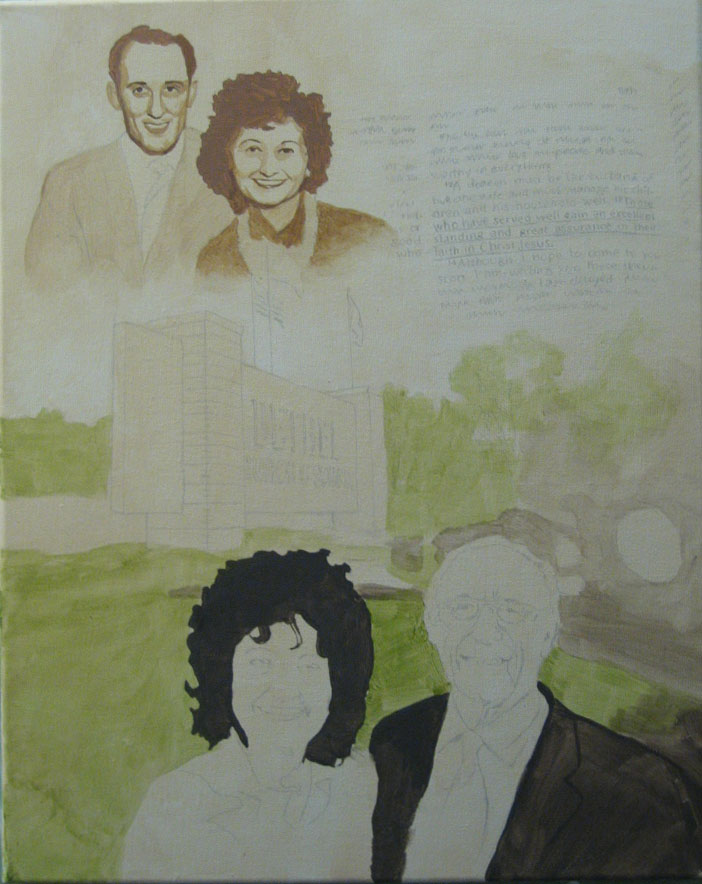
Portrait of Pastor & Mrs. Philip Palser, 16 x 20, acrylic on canvas, 2005 by fine artist Matt Philleo, Step 1
But then as I invest more time into it, I expect that a painting should start “behaving” and looking pretty good, for all the time I put into it. However, that doesn’t always happen. In fact, for me, it usually doesn’t.
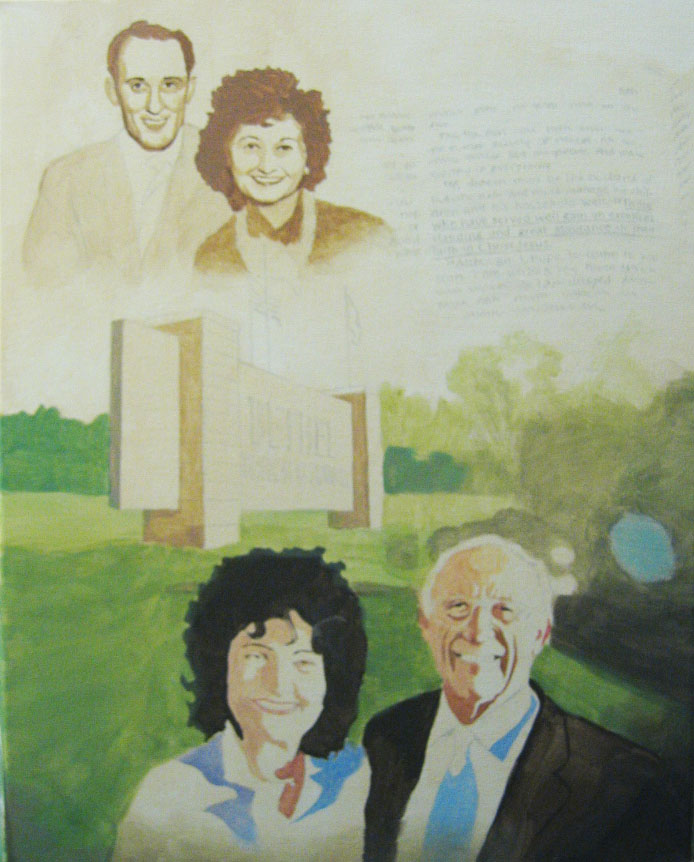
Portrait of Pastor & Mrs. Philip Palser, 16 x 20, acrylic on canvas, 2005 by fine artist Matt Philleo, Step 2
Somewhere around these two stages. the painting looked pretty goofy, and it’s about at this point where my wife remarked, “I don’t know if you can pull this one off.” She said that the pastor’s wife looked like some weird “california girl.”
Even though I was tempted for a moment to give up, I thought something along the lines of, “I know what this needs to look like in the end. I’ve got my reference photo next to me. I’ve got some paint and a palette. Sooner or later, it’s going to look like it should and it will turn out alright.”
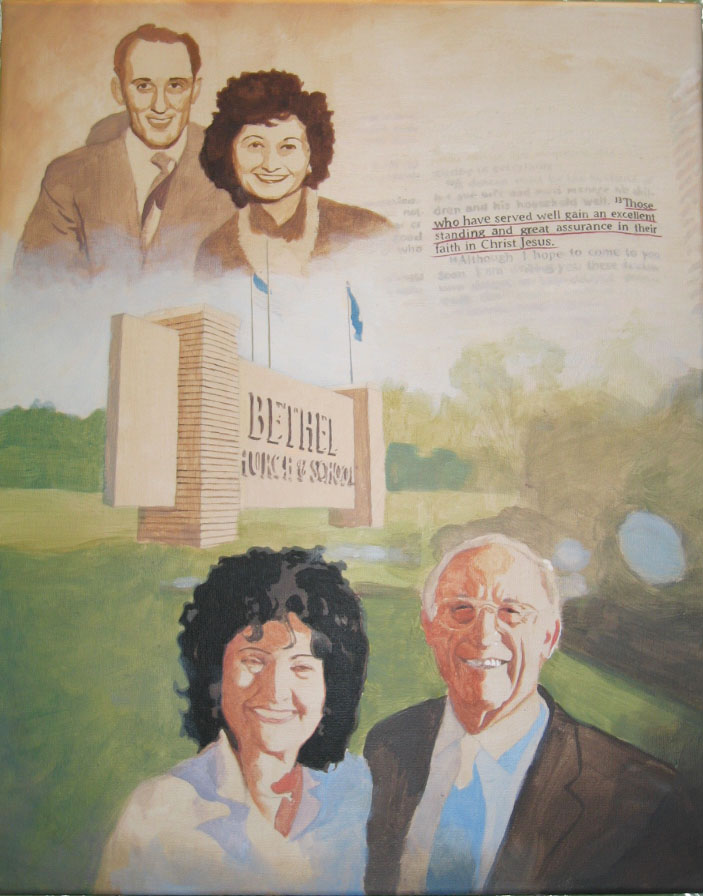
Portrait of Pastor & Mrs. Philip Palser, 16 x 20, acrylic on canvas, 2005 by fine artist Matt Philleo, Step 3
After a few more hours, the painting started to turn the corner. Even though I think I had painted certain areas of the faces a bit too dark, I was able to layer over them with just the right mix of colors to adjust what was off.
When you are establishing values and colors on your faces, sometimes the accuracy you had in your sketch will be thrown off. Capturing these shadows are vital to making a person’s face look like the person you are trying to capture. Since shadows describe the contours and shapes of eyebrow ridges, noses, cheekbones, jawlines, and so many other parts on a human face, it’s important to realize that during the in-between stages, you won’t have an accurate likeness. It’s like a sculptor who has to chisel off many fragments of marble or wood to get the beautiful sculpture that was hiding inside the whole time.
Soon enough, I could see the likenesses taking shape.
That excitement of certain areas of the picture starting to look great then compels you to work even harder to get to the finish line of a signed portrait.
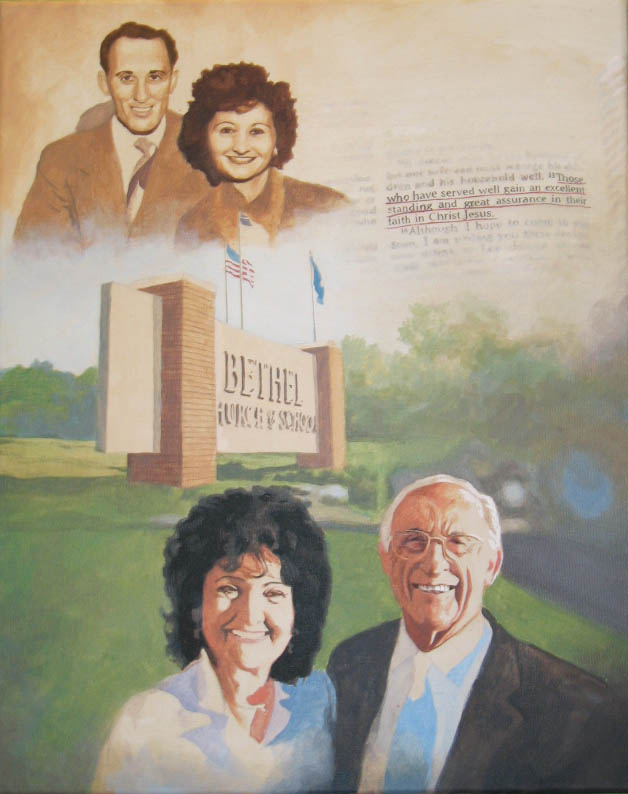
Portrait of Pastor & Mrs. Philip Palser, 16 x 20, acrylic on canvas, 2005 by fine artist Matt Philleo, Step 4
There was still a lot of detail work to do: many nuances to add in the clothing, details in the face and bricks in the church sign. It took a lot of patience, but it paid off. After about 35-40 hours, I had a finished painting!

Portrait of Pastor & Mrs. Philip Palser, 16 x 20, acrylic on canvas, 2005 by fine artist Matt Philleo
I presented this to my pastor and his wife at his 80th birthday party. They loved it. That was 12 years ago, by the way. He is now 92, and still preaches (although not as much as he used to) today!
So again, I want to encourage you: if you are painting a portrait in acrylic, the next time you feel like giving up at a certain part in the process, push past it and keep going. Continually refer back to your reference photo, and paint exactly what you see. If you don’t give up, you will have the confidence knowing that you can finish what you started, and your paintings will never get the best of you. But you will give your paintings the best, and have something excellent to show for your efforts.
I’m writing this post on Good Friday, and this whole idea of finishing what you started, pushing past the difficulty, and seeing what good can come as a result, makes me think of Jesus’ passion. He could have decided as the going got tough–incredibly tough–knowing in advance what He would endure on the cross, to abandon his plan of providing salvation for the world by dying on the cross for our sins.
But instead, he headed for Jerusalem, knowing what would happen to Him there.
In the garden of Gethsemane, when it would have been easier to turn away from the preordained plan of experiencing God’s wrath for sin and even having His relationship with His father broken for a time, he prayed, “Not my will, but yours be done.”
And three days later, we all know…”the rest of the story.”
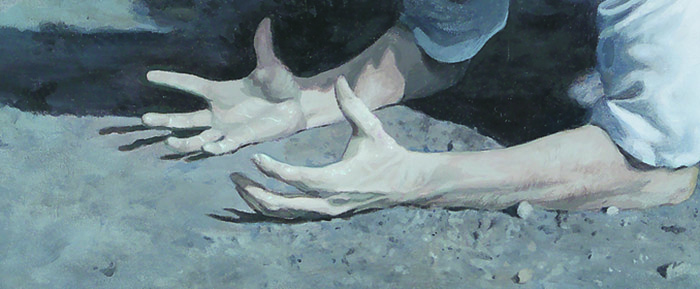
Portion of “Perfect Servant,” acrylic on canvas, 2002, by Matt Philleo
All this to say, there is great reward for not giving up, both in this life and the next. Happy Easter…and Happy painting!

–Matt
Share Your Thoughts!

Recent Comments